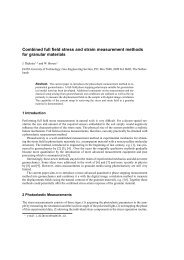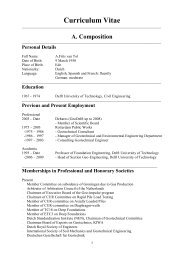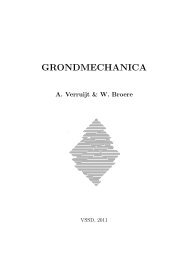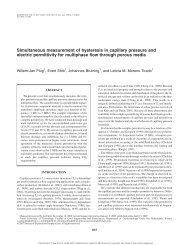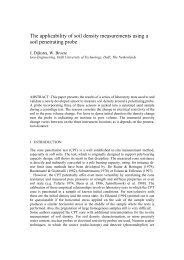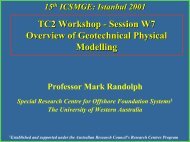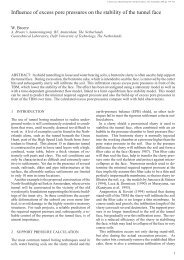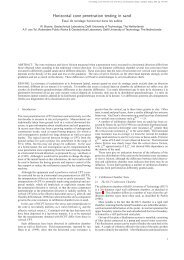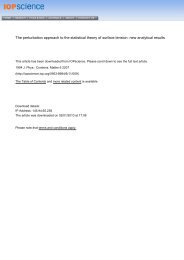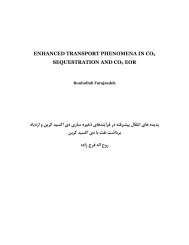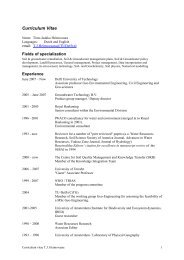Tunnel Face Stability & New CPT Applications - Geo-Engineering
Tunnel Face Stability & New CPT Applications - Geo-Engineering
Tunnel Face Stability & New CPT Applications - Geo-Engineering
Create successful ePaper yourself
Turn your PDF publications into a flip-book with our unique Google optimized e-Paper software.
28 2. <strong>Stability</strong> Analysis of the <strong>Tunnel</strong> <strong>Face</strong>as shown by Steiner [155]. In such cases the reduction of effective support force may becomesignificant, as has been shown by Anagnostou & Kovári.Anagnostou & Kovári assumed that this effect would be unimportant during actual boring andwould only become significant during stand-still. Then the gradual infiltration would underminethe stability of the face over time. They made the implicit assumption, however, that there wouldbe no build-up of excess pore pressures in the soil in front of the TBM due to this infiltration.In soil conditions where excess pore pressures can accumulate in front of the TBM during theexcavation, as observed at the Heinenoord site (see section 2.1.4) such a model does not yield acorrect minimal support pressure [92]. The interplay between infiltration, excess pore pressuresand effective stresses can have a significant influence on the face stability and as such should beincluded in a stability model explicitly.A third effect that needs to be included in a wedge stability model to accurately predict theminimal support pressure is soil arching. Centrifuge tests by Bezuijen & Messemaeckers-van deGraaf [37] for example, combined with postdictions from most stability models, have shown thatthe support pressure at collapse can be accurately predicted only if the effects of soil arching areincluded. Neglecting soil arching and presuming a linear stress distribution with depth wouldlead to much higher minimal support pressures than actually observed. This has also beenobserved by Jancsecz & Steiner and Anagnostou & Kovári, but seems to have been neglectedby Katzenbach.Now that some of the problem areas related to wedge stability models have been recognised,a stability model will be constructed that can deal explicitly with three of these effects; heterogeneitiesat the tunnel face, the infiltration of slurry into the soil in front of the TBM andthe presence of excess pore pressures, which can of course result from the slurry infiltration,but may also have other origins. The following section will first deal with the formulation of awedge stability model which can handle heterogeneities in a straightforward manner. Althoughthe model will be formulated in such a way that it is suited to deal with infiltration and excesspore pressures, those effects will not be included directly, but will be introduced in section 2.2.3and 2.2.3. Before that we will discuss the effects of soil arching and its addition to the stabilitymodel in section 2.2.2. The suitability of the resulting model will be illustrated by field cases insection 2.4 and further discussed in section 2.3.2.2.1 Multilayered WedgeTo construct a wedge stability model, as sketched in figure 2.26, which can handle heterogeneoussoil conditions, the horizontal slice model described by Walz [174] for slurry-filled trenches willserve as a starting point. The failure wedge is subdivided in N smaller bodies, see figure 2.27,possibly of different thickness, inside each of which the soil conditions are homogeneous. Thesoil conditions may vary between these slices, as may the wedge angle θ (i) between the i’thslice’s slanted failure plane and the horizontal.Each slice i is loaded by the resulting forces from the slice above (i − 1) and below (i + 1),Q (i)aG (i)and Q (i)brespectively, the effective weight of the slice itself G (i)w and an overburden forces . At the slanted failure plane there is a cohesive force K (i) acting parallel to the plane, aswell as a friction force R (i) , which results from the normal force N (i) , working perpendicular tothe failure plane. The side faces of the wedge are each assumed to be loaded by the shear forcesT (i) , which act in the same direction as K (i) , against the deformation direction of the wedge.Force equilibrium will yield the effective earth force E (i) at the face which, combined with thewater force W (i) , is equal to the support force S (i) .



